Forget school running knickers, communal showers and forging letters about veruccas, sports therapist and health & fitness blogger Georgina Spenceley says cross country running is fun, inclusive, and can make you a stronger runner overall. Here’s her guide to taking it off road.
Clambering up muddy hills, traipsing across cold streams and pussy-footing through uneven grass fields… not everyone’s idea of fun. But the traditional cross country race is a brilliant way to keep up running fitness through the autumn and winter months. It could make you a stronger road runner and it’s not just for the super speedy. I started entering cross country races with my running club, Harlow Running Club (thehrc.org.uk), a few years ago and was pleased to find people of all different speeds and abilities were taking part. Many running clubs take part in cross country during the season, just contact your local club for more details. The races are all very friendly and well supported, and the hosting club sometimes puts on tea and cakes for runners to warm up and refuel after the race. Bonus!
Three benefits of cross country running:
Increases core stability
We’ve all heard that running on grass is better for your joints than pounding the pavements, but cross country racing takes this theory to a new level. Running on varying surfaces, such as grass, mud, gravel, clay, sand and rocks, gives your stabilising muscles a thorough workout. So not only are you reducing the risk of impact injuries by running on softer surfaces, but you’re increasing stability in your legs and core too.
Sharpens speed and agility
When it comes to racing, the tactics are very different in a cross country race to your typical road race; often the courses are much narrower and the race line doesn’t give much opportunity for overtaking. This is precisely the reason why the front runner from the start usually ends up the first home and dunking custard creams into a warm cuppa. Because of this, cross country races are great for sharpening your speed and agility and training your ability to judge the perfect moment to put in a push to the front of the pack.
Boosts strength
Perhaps the biggest benefit of all is the strength you can gain. Training on hard surfaces, there is a certain amount of energy return as the tendons in the lower legs, particularly the Achilles, act like a spring helping to aid forward propulsion. On soft surfaces, though, much of this energy is lost and more muscle power must be generated to continue forward momentum. As such, strength in the hip flexors, quads, and glutes is increased and the core is challenged in keeping everything stable while these extra muscle contractions occur.
Four top training tips:
Run shorter
Be careful not to do too much too soon, it has been said that every mile you do on the trails is worth 20% more than on the road. This is, in part, because of the loss of energy return. This distance/terrain trade-off often results in injuries as people think they can do the same mileage cross country as they can on tarmac. So if you regularly run 6 miles, stick to a maximum of 4.5 miles off-road to start with and slowly build from there.
Hill hell
As well as your basic endurance training, add some hill reps to your routine to build strength and practice powering up, and down, slippery slopes. Incorporate a mixture of short and long hills in a circuit and perform hill repetitions. Practice running downhill as well, especially on those muddy trails.
Fartlek fun
Speedwork for cross country is more about starting strong and maintaining it, and as such, tempo and pace runs are good for increasing your base aerobic fitness. Fartlek training is also great for getting your body used to picking up on the different surfaces. Pick a good trail circuit near you and play with your speed.
Rest up
As with all training, it’s very important to allow for rest days – perhaps even more so with cross country due to the extra demand placed on the muscles. Follow hard training days with a rest or easy day.
Five prehab exercises for cross country:
To help avoid overtraining injuries, and to gain an edge on the trails, try the following exercises. Each exercise will challenge your balance and coordination, as well as target the muscle groups involved in cross country running.
Perform single-sided exercises, such as the clockwork wobble lunges, to failure* on your weak or non-dominant side and then perform the same number of repetitions on the other side. For bilateral exercises, perform to failure.
*Failure means unable to perform another rep fully or with good form.
Clockwork Wobble Lunges
Standing with your weaker leg on a wobble cushion (you can buy one here), or on a sofa cushion if you haven’t got one, step backwards into a lunge. Return to standing, lifting your free leg up as you do so. Step out to a side lunge, back to a leg raise, and then out to a front lunge. Try not to let your free leg touch the ground between lunges to really challenge your balance.
Jumping Lunges
Start in a lunge with your left leg forward. Jump up and switch your legs to land with your right leg forward. Sink back into a lunge. Try to keep your knees at 90 degree angles and your feet hip width apart when lunging.
Squat to Calf Raise
Standing on a wobble cushion or sofa cushion, sink down into a squat – try to lower until your thighs are parallel to the floor, but don’t force it if you can’t squat that low. Hold for a breath. As you rise, shift the weight to the balls of your feet and rise up to lift your heels off the cushion. Hold for a breath and repeat.
Touch Hops
Standing with your dominant leg elevated behind you (you can use a park bench if outside, or a weights bench in the gym), tip forward from the hips and reach towards the ground with your fingertips until you feel a slight stretch in your hamstrings (back of your thigh). Don’t worry if you can’t touch the ground. From here, lift back up to standing and hop as high as you can off the ground while keeping your back leg planted.
Plank Kicks
Using a park bench, weights bench or bosu ball, lower into a plank position with your hands elevated and arms straight. Try to keep a straight line from your head to your shoulders, bottom and feet. Keep looking down to keep your neck aligned, and don’t let your hips sag. Lift your non-dominant leg and bring your knee towards your hands, then extend your knee to bring your toes to your hands. Don’t worry if your knees and toes don’t touch your hands or the bench, just go as far as you can. Repeat to failure and then switch legs.
You can read Georgina’s blog Fitcetera here and follow her on Twitter.

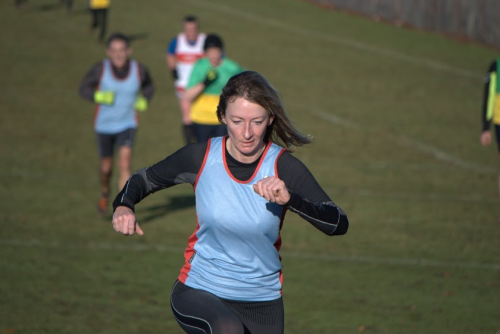
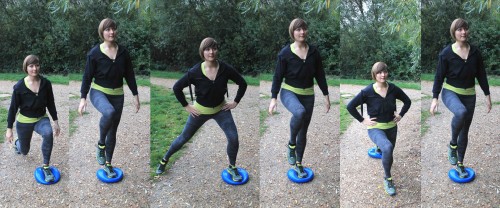
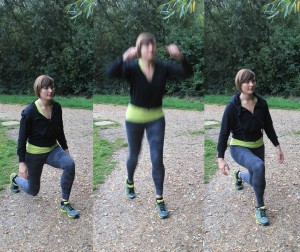
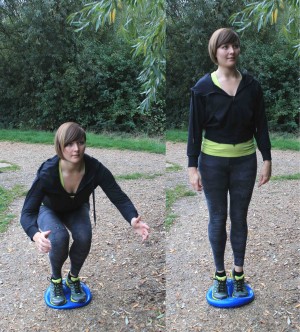
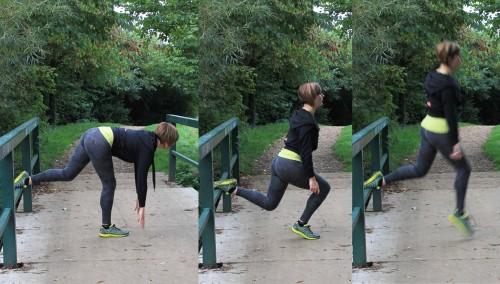
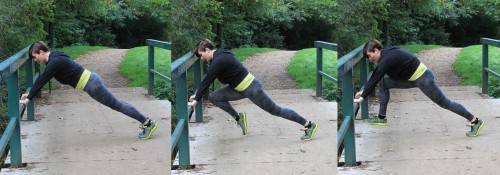




1 Comment